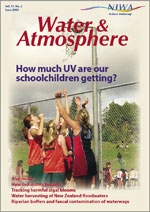PDF of this article (105 KB)

Total Carbon Column Observing Network (TCCON)

Thanks to a grant to NIWA by the International Investment Opportunity Fund (IIOF), New Zealand has joined the United States, Australia, and Germany in the newly established TCCON. By measuring the total amount of greenhouse gases overhead – the ‘total column’ – as well as the concentration at the surface, collaborating scientists will be able to better infer the amount of these gases entering and exiting the atmosphere. This will allow predictions of future greenhouse gas concentrations and, ultimately, a better understanding of the timing and severity of climate warming.
TCCON is a global network of ground-based Fourier Transform spectrometers. Near-infrared solar absorption spectra are measured and analysed to retrieve CO2, CO, CH4, and N2O column densities. Column-integrated trace gas measurements are less sensitive to local sources and sinks and variation in vertical atmospheric mixing than in situ surface measurements. The technique of carbon-column observations is in its infancy and only recently have scientists been able to make the measurements with the required precision. TCCON will be vital to validation of greenhouse gas measurements from space. Currently, both the US and Japan have plans for satellites dedicated to the measurement of carbon-column densities. By participating in the network, New Zealand brings not only a world-class observation site at NIWA in Lauder, but also a great deal of experience in interpreting measurements, especially in understanding how the distribution of gases changes with altitude.
The South Pacific Network, a pre-existing collaboration between New Zealand and Australia, is an integral component of the larger TCCON, and focuses on measurements and modelling relevant to New Zealand. The South Pacific Network expands the TCCON measurement suite to include in situ measurements of the key agricultural gases CH4 and N2O. This is a major step forward for studies of New Zealand’s greenhouse gas emissions, with the first ongoing, continuous measurements of these gases.
As part of this research, NIWA will develop mesoscale models of the distribution of CO2 and CH4 in the New Zealand region. This will aid development of atmospheric transport models of the greater New Zealand region, and enhanced understanding of the carbon cycle in the South Pacific.
For further information, contact: Dr Brian Connor,0-3-440 0428, [email protected] or Dr Vanessa Sherlock, 0-4-386 0466, [email protected]
NIWA in Greenland

Staff at NIWA in Lauder have developed state-of-the-art spectrometer systems for measuring the spectrum of ultraviolet radiation. The purpose of these instruments is to give better insights into the factors, such as ozone and pollution, that cause UV radiation to change. Some have been sold to clients in USA (NOAA), Australia (Bureau of Meteorology), and Japan (University of Tokyo), and NIWA has ongoing contracts with these agencies to maintain the data quality.
Our expertise in UV spectrometry takes us to the farthest corners of the globe. In May, Paul Johnston went to Thule, Greenland, to set up one of our UV spectrometers to assess the performance of a spectrometer that is permanently located there, owned and operated by the Danish Meteorological Institute (DMI). The work is part of a commercial contract with DMI to certify that data from their instrument are up to the exacting standards of the international Network for the Detection of Stratospheric Change.
Thule is inside the Arctic circle (latitude 76.5° N, longitude –68.8° E), and in the middle of the summer it experiences 24 hours of daylight. Though May is early summer in Greenland, Paul reported the outside temperature was a chilly –10°C when he was setting up the instrument. Despite the cold reception, the instrument operated satisfactorily.
For further information, contact: Dr Richard McKenzie, 0-3-440 0429, [email protected]
